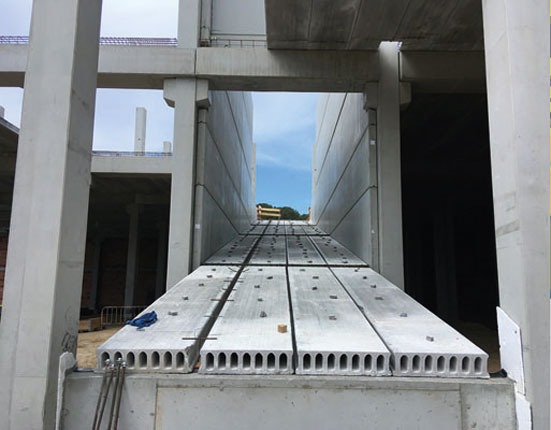Precast concrete has long been a go-to choice in the construction industry for its strength, durability, and quick installation. Its ability to be produced off-site and transported to the construction location for assembly has made it a popular option, especially for large-scale projects. However, traditional methods of managing precast concrete have faced challenges, including measurement errors, delays, and inefficiencies on-site.
With the rise of digital technology, the construction industry has seen the integration of Building Information Modelling (BIM) to streamline design, planning, and execution. By combining the power of BIM with precast concrete, the construction process can become faster, more efficient, and much less prone to errors. This synergy creates a future where projects are completed on time, within budget, and with minimal risk.
In this post, we’ll explore how BIM and precast concrete come together to optimise the construction process. We’ll look at the specific advantages they bring when paired and why their combination can transform how buildings are designed and built.
What is Precast Concrete?
Precast concrete refers to concrete elements that are moulded and cast into shapes at a manufacturing facility before being transported to the construction site. This differs from the traditional approach, where concrete is mixed and poured directly at the building site. Precast elements can include panels, beams, columns, and even entire sections of buildings, all crafted off-site under controlled conditions.
The key benefit of precast concrete lies in its ability to save time. Since much of the work is done in a factory setting, delays caused by weather or onsite issues are minimised. Additionally, precast concrete is often more durable and stronger than cast-in-place concrete, making it ideal for buildings that require longevity and resistance to harsh environments.
What is BIM and How Does It Work?
Building Information Modelling (BIM) is a digital representation of the physical and functional aspects of a building. It involves creating a 3D model of a project that encompasses all the details—from the layout and structure to electrical systems, plumbing, and even materials used. BIM provides all stakeholders involved in the project, including architects, engineers, and contractors, with a comprehensive tool to manage every aspect of construction.
Unlike traditional blueprints or drawings, which are static and provide limited information, a BIM model is dynamic and continuously updated as the project progresses. BIM enables collaboration across disciplines, reduces the risk of mistakes, and provides an accurate visual of the project at any given point. It is an essential tool that modernises construction, allowing teams to visualise potential issues before they arise and make data-driven decisions.
How Precast Concrete and BIM Work Together
When BIM and precast concrete are combined, they bring a new level of efficiency to the construction process. The collaboration between these two technologies makes it easier to design, plan, and execute complex projects that involve precast concrete elements. Here’s how the integration works:
1. Design and Visualisation
BIM provides a detailed 3D model of the entire building, including all precast components. This digital model helps the team visualise how precast elements fit together before production begins. By utilising BIM software, you can simulate the entire construction process, ensuring that all components align with each other perfectly.
The ability to view the project in its entirety enables you to identify and resolve potential design issues before any work begins on-site. It also helps you spot errors early on, reducing costly rework and delays later in the project.
2. Coordination and Collaboration
In traditional construction methods, contractors, designers, and manufacturers often work in silos, which can lead to communication issues and mistakes in the placement of precast elements. BIM facilitates better collaboration by creating a central hub where all stakeholders can access and update the same model in real time.
By integrating precast concrete into a BIM system, all parties involved—from the architects to the precast manufacturers are on the same page. This real-time collaboration ensures that the right parts are produced to the right specifications and delivered at the right time. No more miscommunications about measurements or installation steps, making the entire process smoother.
3. Precast Production and Quality Control
One of the most significant advantages of using BIM with precast concrete is the ability to streamline production. BIM allows for precise measurements, reducing the chances of producing defective elements. The digital model ensures that each precast piece is manufactured to exact specifications, improving the overall quality of the materials used.
Additionally, the model can be used to monitor and track the production process, ensuring that each precast element is created according to the required standards. This level of detail ensures that every part fits perfectly during installation and minimises errors during the construction process.
4. Transportation and Logistics
Once the precast elements are produced, they need to be transported to the construction site. BIM plays a crucial role in optimising the logistics of transporting large and heavy concrete elements. The software can be used to plan the most efficient routes for delivery, ensuring that elements arrive on-site on time and in the correct order.
BIM’s ability to plan logistics down to the smallest detail allows you to avoid delays and reduce transportation costs. Since you can track and adjust schedules as needed, you can avoid the issues that come with last-minute changes or missed deliveries.
5. Installation and On-Site Efficiency
When it comes time to install the precast concrete elements, BIM ensures that everything is ready for a smooth and efficient process. The model provides a clear and accurate representation of where each piece fits, making it easier for contractors to place the elements quickly and accurately.
BIM also helps reduce the need for rework on-site. Since every detail is planned out in advance, the chances of errors during installation are significantly reduced. This means fewer delays and less wasted time, making the entire project more efficient.
Benefits of Combining Precast Concrete with BIM
The combination of precast concrete and BIM can bring a range of benefits to the construction process:
- Improved Accuracy: BIM ensures that every precast element is designed, manufactured, and installed to precise specifications. This reduces the likelihood of errors and ensures the finished product meets all the necessary standards.
- Faster Project Delivery: By eliminating mistakes and improving coordination between teams, BIM and precast concrete speed up the construction process. Elements can be produced off-site while site preparation is underway, reducing the overall timeline.
- Cost Savings: The integration of BIM helps minimise waste and reduce the need for rework. By optimising production, delivery, and installation, BIM and precast concrete help reduce costs throughout the project lifecycle.
- Sustainability: Since BIM allows for precise planning, it helps to optimise the use of materials, reducing waste and improving sustainability. Precast concrete, when paired with BIM, supports green building initiatives by minimising the environmental impact of the construction process.
- Enhanced Collaboration: With BIM’s collaborative features, all stakeholders—from designers to manufacturers—work together seamlessly. This ensures everyone is aligned on the project’s goals and reduces the risk of conflicts during construction.
Conclusion
The integration of precast concrete with Building Information Modelling (BIM) is a game-changer for the construction industry. This powerful combination streamlines the entire process from design and production to installation, resulting in faster project delivery, higher accuracy, and reduced costs. By adopting BIM, you gain a tool that enhances collaboration, ensures quality, and enables more efficient resource utilisation.
As the construction industry continues to embrace digital transformation, the integration of BIM and precast concrete will become increasingly prevalent. If you’re looking to stay ahead of the curve and increase the efficiency of your projects, this match made in construction heaven is an essential part of your toolkit.







